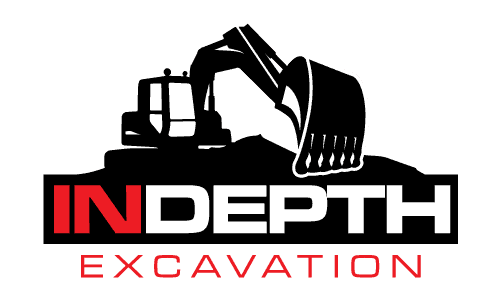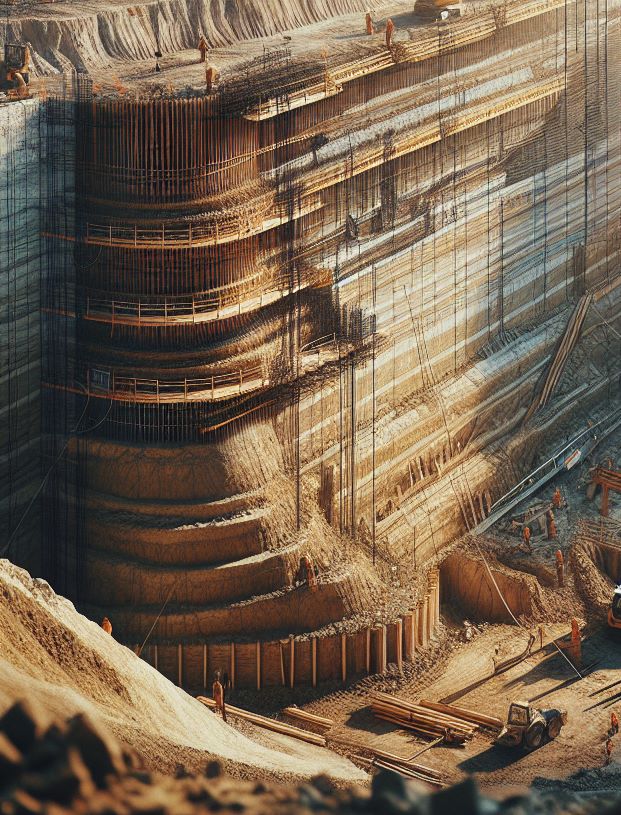Understanding What Sloping Excavation Is in Excavation
Welcome to In-Depth Excavations Guide to Sloping Excavation!
Sloping excavation is a crucial technique used in construction projects to create stable and safe excavations. By strategically inclining the sides of the excavation, it ensures the surrounding soil remains supported and prevents potential cave-ins. This informative guide by In-Depth Excavation, your trusted excavation partner in King, Snohomish, and Skagit Counties, delves into the various methods, steps involved, and safety protocols associated with sloping excavation.
A Simple Answer for What is Sloping in Excavation
Sloping excavation is a crucial technique in construction, involving the strategic manipulation of the excavation walls. Unlike a vertical cut, the walls are cut back at an angle that inclines away from the excavation itself. This angle, measured in degrees or as a ratio of horizontal distance to vertical distance (e.g., 1.5:1), plays a critical role in maintaining stability and preventing potential cave-ins. Here are some key factors that determine the safe and achievable slope angle:
Soil Type and Stability:
- Cohesive soils like clay or silt generally have higher inherent stability, allowing for steeper slope angles compared to non-cohesive soils like sand or gravel.
- Loose or disturbed soils: These require shallower slope angles due to their reduced ability to support their own weight and resist collapse.
Depth of Excavation:
- Shallower excavations: These can typically have steeper slopes due to the reduced weight exerted on the lower walls.
- Deeper excavations: These require gentler slopes to maintain stability as the weight of the soil increases with depth.
Presence of Water:
- Water acts as a lubricant, reducing the internal friction within the soil and weakening its overall stability.
- The presence of groundwater or surface water infiltration necessitates flatter slopes to prevent the saturated soil from collapsing.
Understanding these factors alongside professional soil analysis is crucial for selecting the appropriate slope angle and ensuring the safety of your excavation project. In-Depth Excavation offers comprehensive soil testing and analysis services to assist you in making informed decisions for your specific project needs.
Techniques Involved In Sloping for Excavation
Regardless of the chosen sloping method, specific techniques are essential for successful implementation:
Shoring and Bracing:
- In deeper excavations or unstable soil conditions, temporary shoring systems like sheet piles or soldier piles are used to reinforce the excavation walls, preventing cave-ins.
Drainage Control:
- Implementing a proper drainage system is crucial to prevent water accumulation within the excavation, which can weaken the soil and compromise the stability of the slopes.
Monitoring and Inspection:
- Regularly monitoring the excavation walls and surrounding areas for any signs of instability, cracks, or movement is essential for ensuring safety throughout the project.
Steps Involved for the Methods
Understanding Your Soil
Key Soil Characteristics for Sloping Projects:
Soil Type: There are several soil types, like clay, silt, sand, loam, or a mix. Each type behaves differently. For instance, sandy soil drains quickly but doesn’t hold shape well, while clay is great at holding shape but has poor drainage. Knowing your soil type helps determine how to approach the slope without causing issues like erosion or landslides.
Moisture Content: The amount of water in your soil can significantly affect your sloping project. Too much moisture might make the soil unstable, while too little could make it too hard to work with. It’s all about finding that Goldilocks zone – just right.
Compaction: This refers to how tightly soil particles are packed together. Highly compacted soil can support more weight, making it better for certain types of slopes or structures. However, it’s also harder to excavate or change.
Organic Matter: Soil rich in organic matter might be great for gardens, but when it comes to slopes, it can be tricky. Organic material decomposes, which can change the soil structure over time. This might lead to instability in your sloped area.
Erosion Potential: Some soils are more prone to erosion than others. Factors like soil type, slope steepness, and rainfall patterns play into this. Erosion can undermine your project, so it’s important to plan for it.
Safety Procedures for Sloping Excavation
Simple Slope:
- Marking and layout: Clearly mark the desired slope angle on the excavation walls.
- Excavation: Carefully excavate the soil while maintaining the designated slope angle throughout.
- Monitoring and inspection: Regularly monitor the slope for signs of instability and implement corrective actions if necessary.
Compound Slope:
- Marking and layout: Mark the transition points and desired slope angles for each section on the excavation walls.
- Excavation: Excavate each section of the slope according to the designated angles, starting from the top and working your way down.
- Monitoring and inspection: Continuously monitor the slopes for any signs of instability and adjust the plan as needed.
Benching:
- Marking and layout: Mark the dimensions and locations of each bench on the excavation walls.
- Excavation: Excavate the first level of the excavation to the designated depth and width, creating the first bench.
- Repeat: Continue excavating the subsequent levels, creating each bench as you progress down the depth of the excavation.
Monitoring and inspection:
Regularly monitor the benches and slopes for signs of instability and take corrective actions if required. This step may seem self-explanatory but it is vital for any sloping project. A poor slope can cause many problems for any project, home, or business, affecting the ecosystem in potentially catastrophic ways.
Following OSHA regulations:
- We ensure compliance with all Occupational Safety and Health Administration (OSHA) regulations on sloping and excavation safety.
Proper worker training:
- Our crew members receive comprehensive training on safe sloping techniques, recognizing potential hazards, and utilizing personal protective equipment (PPE) correctly.
Regular inspections:
- We conduct regular inspections of the excavation walls, shoring systems, and surrounding areas to identify and address any potential
Choosing In-Depth Excavation for your Sloping Excavation Project
In-Depth Excavation has been your local experts for years now, with a highly skilled crew to see through your projects, we’ve been a premium choice for home and business owners alike. With our dedication to Eco-Friendly practices and ensuring your project is sound for years to come, our pride comes from our client’s satisfaction.
We’re like the soil whisperers. We come in with our expertise and equipment for the soil on your site. Why does this matter to you? Because it takes the guesswork out of planning your sloping project. Here’s what we bring to the table:
-
Thorough Soil Testing: We get down and dirty with your soil, checking out its type, moisture level, compaction, and more. It’s like a health check-up, but for the ground.
-
Expert Analysis: Once we know what we’re working with, we’ll tell you what it all means. If your soil is looser and freer or more like it’s ready to hold up the Leaning Tower of Pisa, we’ve got you covered.
-
Tailored Solutions: With our insights, we can recommend the best sloping techniques for your specific soil. Whether it’s adjusting the slope angle, choosing the right retaining solutions, or recommending pre-treatment of the soil, we’re on it.
Call or Contact us today to get a free quote to bring your dream project into reality, cause after all, Your Hole is our goal!
Company: In-Depth Excavation
Phone Number: (425)-367-1521
Website: In-Depth Excavation (indepthex.com)
Address: 14751 N. Kelsey St. SE Suite #105
Google My Business: Snohomish – Google Maps
FAQs about Sloping Excavation with In-Depth Excavation:
Sloping excavation involves strategically tilting the walls of an excavation inwards, away from the pit. This technique is crucial for maintaining stability and preventing cave-ins. Different soil types, excavation depths, and water presence influence the safe and achievable slope angle.
Several methods exist, each with its advantages:
- Simple Slopes: This straightforward method uses a single, uniform angle throughout the excavation.
- Compound Slopes: This method employs two or more angles at different depths, often used for deeper excavations or varying soil conditions.
- Benching: This approach involves creating horizontal steps within the excavation walls, offering additional support for deep or unstable excavations.
Here’s a simplified overview of the steps involved in common methods:
Simple Slope:
- Assess soil and determine a safe slope angle.
- Mark and layout the desired slope on the excavation walls.
- Excavate carefully, maintaining the designated angle.
- Continuously monitor the slope for stability.
Compound Slope:
- Analyze soil characteristics at different depths to determine suitable angles.
- Mark the transition points and designated angles on the walls.
- Excavate each section according to the angles, starting from the top.
- Monitor the slopes for any signs of instability and adjust as needed.
Benching:
- Assess soil and determine safe dimensions for each bench (depth and width).
- Mark the locations and dimensions of each bench on the excavation walls.
- Excavate the first level to the designated depth and width, creating the first bench.
- Repeat steps for subsequent levels, creating each bench as you progress downward.
- Regularly monitor the benches and slopes for stability and make adjustments if necessary.
Understanding your soil type and its properties is critical for choosing the appropriate method and ensuring safety. In-Depth Excavation offers soil testing and analysis services to provide the necessary information for informed decision-making.
In-Depth Excavation prioritizes safety through:
- Following OSHA regulations for sloping and excavation safety.
- Providing comprehensive training to crew members on safe sloping techniques, hazard recognition, and proper use of PPE.
- Conducting regular inspections of the excavation walls, shoring systems, and surrounding areas to identify and address potential hazards.
By partnering with In-Depth Excavation, you can ensure your sloping excavation project is completed safely, efficiently, and with expert guidance.



